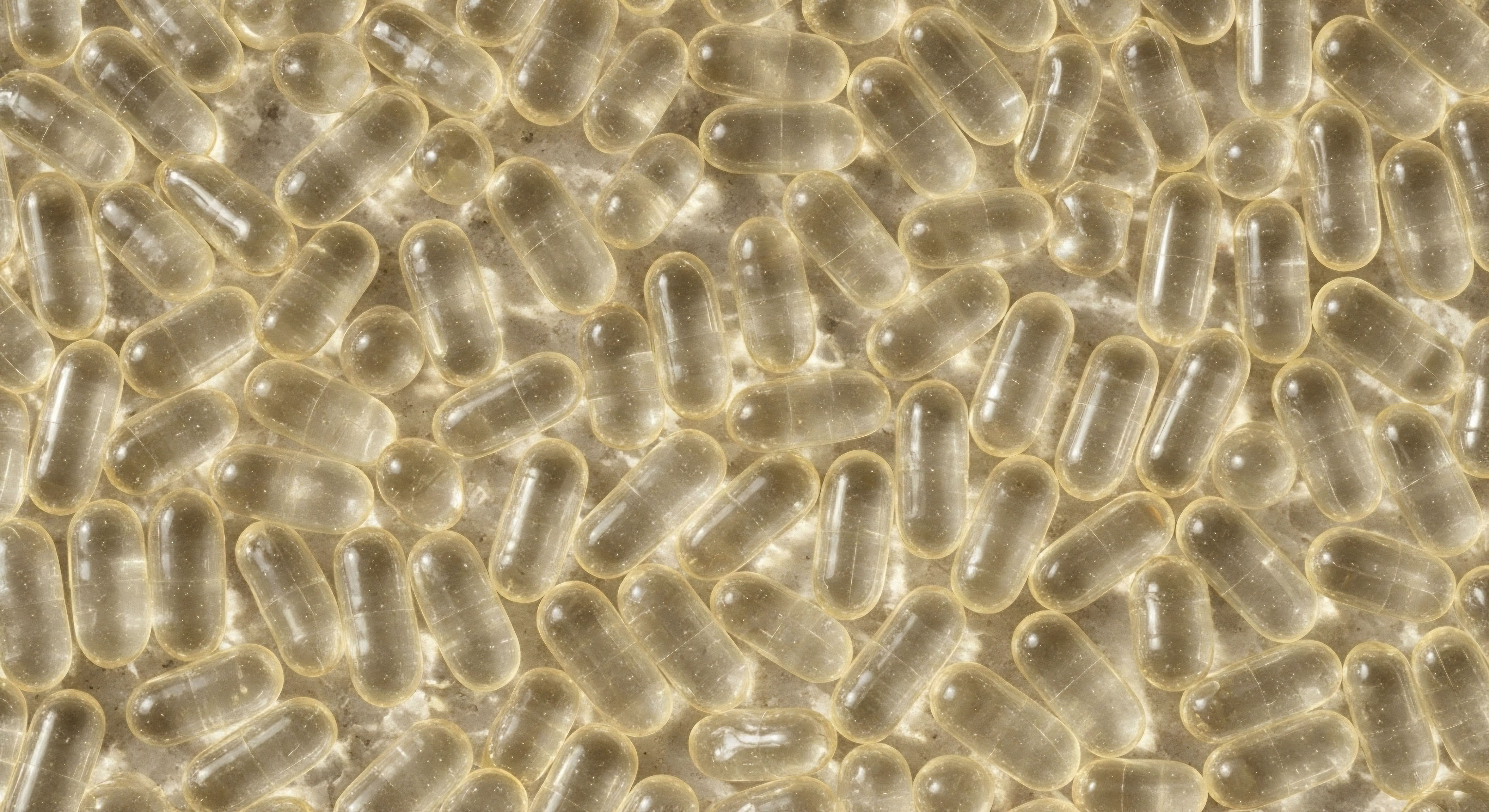

Fundamentals

Your Body’s Stabilizing Signal
You may feel it as a subtle shift in your sleep quality, a new undercurrent of anxiety, or changes in your menstrual cycle. These experiences are valid biological signals, pointing toward fluctuations within your endocrine system. Progesterone is a principal actor in this internal orchestra, a steroid hormone synthesized from cholesterol, primarily in the ovaries, adrenal glands, and, during pregnancy, the placenta.
Its role extends far beyond reproduction. It is a fundamental regulator of mood, sleep architecture, and inflammation. Understanding its function is the first step toward deciphering your body’s messages and addressing the root causes of symptoms that disrupt your sense of well-being.
The conversation around hormonal health often begins with a symptom, a personal experience that feels isolating. Yet, the underlying mechanism is a shared human biology. When we speak of progesterone therapy, we are discussing the clinical application of a substance your body already knows intimately.
The goal of such a protocol is to restore physiological balance, using a molecule identical to the one your own tissues produce. This biochemical recalibration is designed to support the body’s innate systems, addressing deficiencies that can manifest as poor sleep, heightened stress responses, or menstrual irregularities. The process is a collaborative one between you and a clinician, grounded in laboratory data and your subjective experience, aimed at restoring function and vitality.

Why Delivery Method Is a Critical Decision
The method chosen to supplement progesterone is as important as the dose itself. Each delivery system represents a distinct biological pathway, fundamentally altering how the hormone is absorbed, metabolized, and utilized by your tissues. This decision directly shapes the therapeutic outcome and the potential for side effects.
For instance, a protocol designed to optimize sleep will leverage a delivery method that promotes the creation of specific calming metabolites in the brain. Conversely, a protocol focused on uterine health requires a method that ensures high concentrations of progesterone directly in the endometrial tissue. The choice is a strategic one, tailored to your unique physiology and wellness goals. It is a clear example of how personalized medicine translates complex biochemistry into a targeted, effective wellness plan.
Progesterone’s influence extends beyond reproductive health, acting as a key regulator of the nervous system and inflammatory response.

Foundational Delivery Pathways
To understand progesterone dosing, one must first appreciate the primary routes of administration and their distinct physiological journeys. These pathways determine the hormone’s bioavailability, the speed of its action, and the specific tissues it will most effectively reach.
- Oral Administration This involves swallowing a micronized progesterone capsule. Micronization is a process that reduces the particle size of the hormone, enhancing its absorption in the gastrointestinal tract. This route is unique because the progesterone is processed by the liver before entering systemic circulation.
- Transdermal Administration This method uses a cream or gel to deliver progesterone through the skin directly into the bloodstream. It bypasses the initial liver metabolism, leading to a different metabolic profile compared to the oral route.
- Vaginal Administration Progesterone can be delivered directly to the vaginal tissues via suppositories, gels, or rings. This route provides a highly efficient pathway to achieving high concentrations in the uterine tissue, a phenomenon known as the “uterine first-pass effect.”
- Injectable Administration Progesterone can be administered via intramuscular or subcutaneous injection. This method ensures 100% bioavailability, delivering the hormone directly into the systemic circulation for widespread distribution.


Intermediate

Bioidentical Progesterone versus Synthetic Progestins
In the landscape of hormonal optimization, a critical distinction exists between bioidentical progesterone and synthetic progestins. Bioidentical progesterone possesses the exact molecular structure as the hormone produced by the human body. This structural identity allows it to bind perfectly to progesterone receptors and be metabolized through predictable, natural pathways.
Synthetic progestins, such as medroxyprogesterone acetate (MPA), were developed to mimic the effects of progesterone but have a different chemical structure. This molecular difference means they can interact with other steroid receptors, leading to a wider range of off-target effects. Clinical evidence has illuminated the consequences of these differences.
Observational studies, particularly large-scale French cohort studies, have shown that synthetic progestins, when combined with estrogen, are associated with an increased risk of breast cancer. Conversely, bioidentical progesterone does not appear to carry this same risk. Similarly, bioidentical progesterone tends to exert a neutral or even beneficial effect on cardiovascular markers like lipids and blood pressure, while certain synthetic progestins may have adverse impacts.

How Is the Right Progesterone Dose and Method Determined?
The selection of a specific progesterone dose and delivery route is a process of clinical reasoning, integrating patient-specific data with established therapeutic principles. The decision is guided by the primary goal of the therapy, the patient’s metabolic tendencies, and their individual tolerance.
For example, in menopausal hormone therapy, the primary role of progesterone is to protect the uterine lining from the proliferative effects of estrogen. In this context, a dose of 200 mg of oral micronized progesterone for 12 days per month is a standard, evidence-based protocol to prevent endometrial hyperplasia.
However, if a patient also experiences significant sleep disruption, the oral route becomes doubly advantageous due to its sedative metabolites. If a patient experiences side effects from oral progesterone, such as dizziness, or if the primary goal is localized uterine support, vaginal progesterone may be the superior choice. This route achieves uterine tissue concentrations up to ten times higher than oral administration, with lower systemic levels, minimizing side effects.
The choice between bioidentical progesterone and synthetic progestins is a significant clinical decision, with data suggesting different risk profiles for breast and cardiovascular health.

Comparing Progesterone Delivery Methods
Each method of progesterone administration offers a unique pharmacokinetic profile, which a clinician leverages to achieve specific therapeutic goals. The table below outlines the key characteristics and clinical applications of the most common delivery routes.
| Delivery Method | Absorption & Metabolism | Primary Clinical Applications | Common Dosing Regimens |
|---|---|---|---|
| Oral Micronized | Absorbed via GI tract; undergoes extensive first-pass metabolism in the liver, creating neurosteroid metabolites. | Endometrial protection, sleep support, anxiety reduction. | 100-200 mg daily or cyclically at bedtime. |
| Vaginal | Bypasses liver metabolism; high local uptake in uterine tissue (uterine first-pass effect). | Fertility protocols, endometrial protection with minimal systemic effects. | 90-100 mg daily or every other day. |
| Intramuscular | Bypasses liver metabolism; provides sustained, high systemic levels. 100% bioavailability. | Luteal phase support in assisted reproduction; situations requiring guaranteed high serum levels. | 25-100 mg daily or every other day. |
| Transdermal | Bypasses liver metabolism; absorption can be variable depending on skin type and application site. | Symptom relief for PMS; often used in compounded formulations. | Dosage is highly variable and depends on the specific compounded formulation. |

Personalizing the Protocol
Optimizing a progesterone protocol is an iterative process. It begins with a standard, evidence-based dose and delivery method, which is then refined based on the patient’s response and, if necessary, follow-up laboratory testing. For instance, a patient taking oral progesterone for sleep might find 100 mg insufficient but 200 mg causes morning grogginess.
The dose can be titrated to find the optimal balance. Similarly, a woman using vaginal progesterone who experiences irritation may be switched to an oral or transdermal preparation. This process of personalization ensures that the therapeutic protocol is aligned not just with the clinical goal, but with the individual’s lived experience and physiology.


Academic

Pharmacokinetic Disparities among Administration Routes
The clinical efficacy of progesterone is inextricably linked to its pharmacokinetics, which vary profoundly with the route of administration. Oral micronized progesterone undergoes extensive first-pass metabolism in the liver, resulting in a bioavailability of less than 10%. This hepatic transit is not a loss of function but a biotransformation.
The liver converts progesterone into a spectrum of metabolites, most notably allopregnanolone and pregnanolone. These metabolites are responsible for the distinct neuropharmacological profile of oral progesterone. In stark contrast, parenteral routes such as vaginal, transdermal, and intramuscular administration circumvent the portal circulation, thereby avoiding this extensive hepatic metabolism.
Vaginal delivery is characterized by a unique “uterine first-pass effect,” where the hormone is preferentially absorbed into the uterine vasculature, leading to high endometrial tissue concentrations despite relatively modest serum levels. Intramuscular injection of progesterone in an oil depot results in sustained, predictable, and often supraphysiological serum concentrations, making it a reliable method for ensuring systemic exposure.
The extensive first-pass hepatic metabolism of oral progesterone is not a limitation but a unique therapeutic pathway, generating neuroactive steroid metabolites with distinct clinical benefits.

The Neurosteroid Effects of Oral Progesterone Metabolites
The primary clinical distinction of oral progesterone lies in its metabolic conversion to neuroactive steroids. Allopregnanolone, a 3α,5α-reduced metabolite of progesterone, is a potent positive allosteric modulator of the gamma-aminobutyric acid type A (GABA-A) receptor complex. This is the principal inhibitory neurotransmitter system in the central nervous system.
By binding to the GABA-A receptor, allopregnanolone enhances the influx of chloride ions into the neuron, leading to hyperpolarization and a subsequent reduction in neuronal excitability. This mechanism is functionally analogous to that of benzodiazepines and barbiturates, explaining the anxiolytic, sedative, and hypnotic properties of oral progesterone.
This neuropharmacological action is a key consideration in clinical practice. For a patient whose symptom profile includes insomnia or anxiety alongside hormonal imbalance, oral progesterone offers a dual therapeutic benefit. It provides the necessary progestogenic effects for endometrial protection while simultaneously leveraging its metabolites to address neurological symptoms. This makes oral progesterone a form of pro-drug for allopregnanolone, where the therapeutic intent is targeted as much at the brain as it is at the uterus.

What Is the Clinical Significance of Receptor Binding Profiles?
The divergence between bioidentical progesterone and synthetic progestins is rooted in their receptor binding affinities. Bioidentical progesterone interacts specifically with the progesterone receptor. Synthetic progestins, however, due to their altered molecular structures, can exhibit cross-reactivity with androgen, glucocorticoid, and mineralocorticoid receptors. This promiscuous binding profile is the biochemical origin of many of their undesirable side effects.
For example, the androgenic activity of some testosterone-derived progestins can lead to acne or unfavorable lipid changes. The structural dissimilarity also affects how these molecules interact with breast tissue. Progesterone itself has a complex, often anti-proliferative role in breast epithelium.
In contrast, the combination of conjugated equine estrogens and the synthetic progestin medroxyprogesterone acetate was shown in the Women’s Health Initiative (WHI) study to increase the risk of breast cancer, a risk not observed with bioidentical progesterone. This underscores the principle that molecular structure dictates biological function, and that “progestogen” is a broad term for a class of substances with highly variable physiological effects.

Advanced Pharmacokinetic Considerations
A deeper analysis of progesterone’s pharmacokinetics reveals further subtleties that inform clinical decision-making. The table below contrasts key parameters across different administration routes, providing a quantitative basis for protocol design.
| Pharmacokinetic Parameter | Oral | Vaginal | Intramuscular | Transdermal |
|---|---|---|---|---|
| Bioavailability | <10% | High (~4-8% systemic but higher locally) | 100% | Variable |
| Time to Peak Concentration | 1-2 hours | ~6 hours | ~8 hours | Variable (slow) |
| Elimination Half-Life | 5-10 hours | 14-50 hours | 20-28 hours | 30-40 hours |
| Key Metabolites | Allopregnanolone, Pregnanolone | Minimal systemic metabolites | Minimal systemic metabolites | Minimal systemic metabolites |
This data illustrates why oral progesterone requires daily dosing (short half-life) and is ideal for inducing sleep, while intramuscular injections can be administered less frequently. The long half-life of vaginal progesterone provides stable, sustained local tissue levels, which is ideal for applications in assisted reproductive technology.
The variability and slower absorption of transdermal progesterone make it a less reliable option for indications requiring precise and stable serum concentrations, such as endometrial protection in the context of high-dose estrogen therapy.

References
- de Lignières, B. “Oral micronized progesterone.” Clinical therapeutics 21.1 (1999) ∞ 41-60.
- Stanczyk, Frank Z. “Pharmacokinetics of progesterone administered by the oral and parenteral routes.” Journal of reproductive medicine 44.2 Suppl (1999) ∞ 141-7.
- Asi, N. et al. “Progesterone vs. synthetic progestins and the risk of breast cancer ∞ a systematic review and meta-analysis.” Systematic reviews 5.1 (2016) ∞ 1-8.
- Di Renzo, Gian Carlo, et al. “Progesterone in normal pregnancy and recurrent miscarriage.” Best Practice & Research Clinical Obstetrics & Gynaecology 21.5 (2007) ∞ 825-840.
- Melcangi, Roberto C. et al. “Allopregnanolone ∞ An overview on its synthesis and effects.” Journal of neuroendocrinology 31.9 (2019) ∞ e12776.
- Schumacher, M. et al. “Progesterone and allopregnanolone ∞ neuroprotective and myelin-repairing properties.” Neuroscience 191 (2011) ∞ 75-85.
- Andréen, L. et al. “Pharmacokinetics of progesterone and its metabolites allopregnanolone and pregnanolone after oral administration of low-dose progesterone.” Maturitas 53.2 (2006) ∞ 158-166.
- The Writing Group for the PEPI Trial. “Effects of estrogen or estrogen/progestin regimens on heart disease risk factors in postmenopausal women.” JAMA 273.3 (1995) ∞ 199-208.
- Fournier, A. et al. “Unequal risks for breast cancer associated with different hormone replacement therapies ∞ results from the E3N cohort study.” Breast cancer research and treatment 107.1 (2008) ∞ 103-111.
- Sitruk-Ware, R. “Pharmacological profile of progestins.” Maturitas 65 (2010) ∞ 2-7.

Reflection
The information presented here provides a map of the biochemical pathways and clinical strategies involved in progesterone therapy. This knowledge serves as a powerful tool, transforming the abstract feelings of being unwell into a set of understandable biological processes. Your personal health narrative is unique, yet it unfolds within these shared physiological frameworks.
The path forward involves integrating this objective scientific understanding with your own subjective experience. This synthesis is where true personalization begins, allowing you to ask more precise questions and make more informed decisions in collaboration with your clinical guide. The ultimate goal is to move from a state of questioning your symptoms to a place of understanding your system, reclaiming a sense of agency over your own vitality and function.



